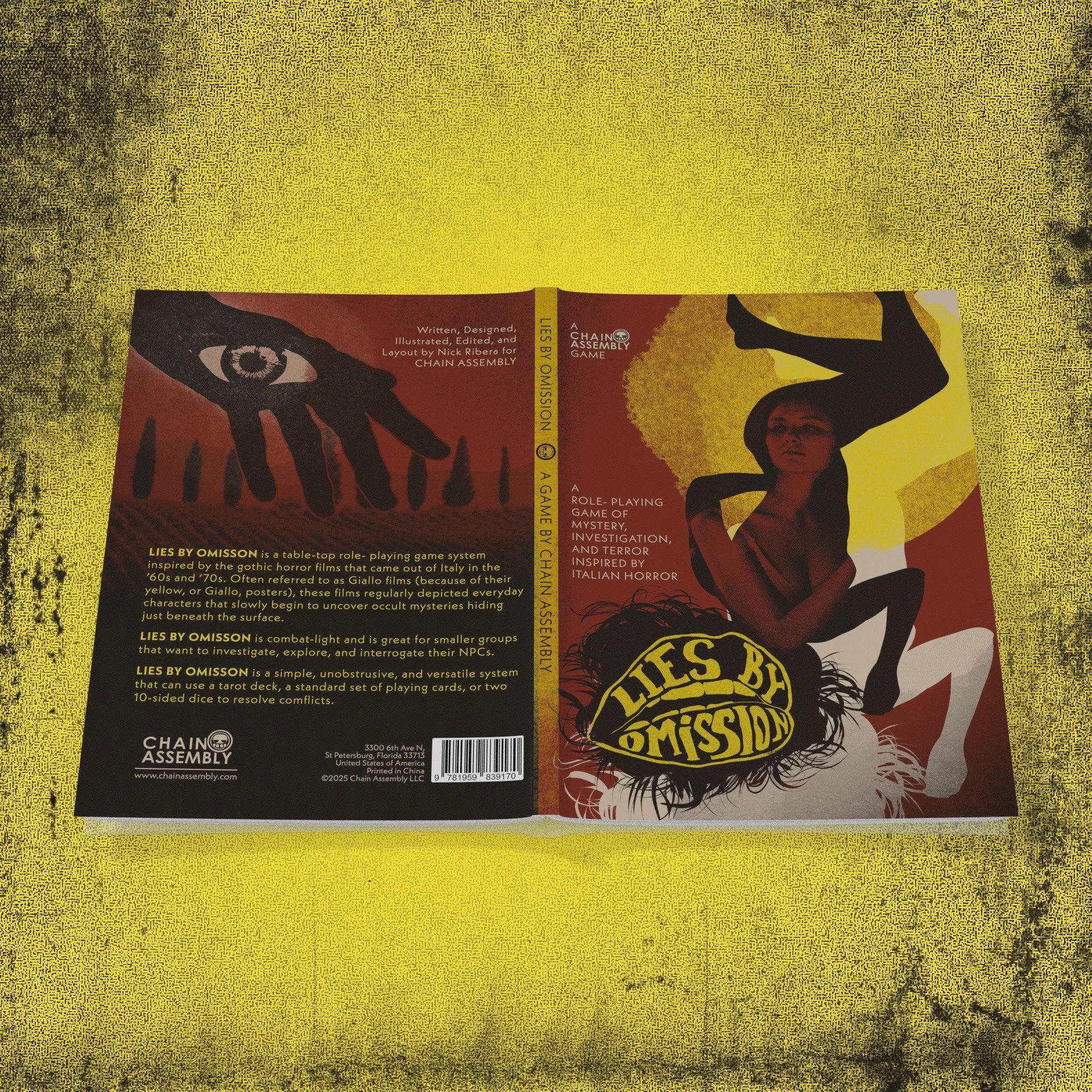1970’s Italian Horror Mysteries! First Look at Lies by Omission & L’Isola Lacrime
By JimmiWazEre
Opinionated tabletop gaming chap
TL;DR:
Lies by Omission is a rules-lite, tarot-driven horror RPG steeped in the mood of 1960s–70s Italian Giallo cinema. It’s gorgeously presented and thematically confident, with evocative art, clever pacing tools, and a distinct cinematic flair. If you’re into atmospheric, story-first experiences and Italian horror vibes, it’s absolutely worth a look. If you prefer games where mechanics drive tension and consequence, this one might not be for you.
Disclaimer
A few months ago, I was sent the physical press kit for Lies by Omission (LxO) by the creator with a request that I might feature it in an upcoming post. At the time of receipt, this kit represented a work in progress state of the game, with certain elements missing and others awaiting their final polish. As per usual, I have not received financial incentive to write nice things.
Finally, it’s well worth noting that I’ll be presenting this in a ‘first look’ format as I’ve not played LxO yet, so don’t go thinking that this a review :)
What Is Lies by Omission?
Just the Facts
| Type | TTRPG |
| Theme | Giallo, Horror |
| Players | 2-5 |
| Ages | Explicitly Adult |
| Dev | Chain Assembly |
| Pages | 68 |
Created and edited by Nick Ribera and Leslie Haas of Chain Assembly and launched on Gamefound just the other day, Lies by Omission (LxO) and it’s accompanying campaign setting; L’isola Lacrime achieved their modest funding goal of $1,000 in a mere 7 minutes - that’s roughly $2.40 per second, and a pretty decent salary by anyone’s reckoning.
More importantly, it demonstrates the clear appeal that the project has managed to generate against a backdrop of so many otherwise ignored indie RPGs. Congratulations Chain Assembly!
In fact, as of the time of writing, with 26 days to go until the Gamefound completes, it’s currently sitting on $9.9k from 120 backers. Plenty of time left for you to join the crowd and get involved if you like the sound of it.
What’s it Trying to Do?
Core Rules
Fundamentally LxO tries to capture the tone and aesthetics of 1960s and 70s Italian Giallo films - thrillers that mixed mystery, horror, and eroticism, often featuring stylized violence, psychological tension, and vivid visual design.
I must confess, it’s not a horror sub-genre that I’m particularly knowledgeable about - but despite this, I was surprised by how familiar I was with the key cultural ingredients which carry the game forwards, to the extent that I can’t imagine that I’d have any problems running it.
From my readthrough, it’s clear to me that Ribera and Haas are trying to double down on these striking vibes whilst attempting to offer a rules-lite framework for the GM (Director) to operate from. The books, props, even the suggested Spotify playlist all serve well to boil that theme into a juicy stew and then inject it directly into your face, whilst the simple game mechanics on the players side seem to want to stay out of the way as much as possible.
This manifests as a very mechanically light, narrative focused game. I get the impression that it’ll feel less like playing a gamey game in the traditional RPG sense, and more about inhabiting a mystery story that’s already partially written, with the mechanics as more of a faint pulse beneath the surface rather than a driving engine.
L’isola Lacrime
In addition to the core rules, there’s a campaign setting; L’isola Lacrime, which takes place on an island in the Mediterranean sea. This setting provides the GM with a bunch of mysteries which all link together, combining a wealth of locations, NPCs, factions, events into a cohesive whole which could be used piecemeal for a one shot, or over the course of a sandbox style campaign.
As with the core rules, the campaign setting maintains the style and vibes of Giallo films; strange locals, secretive institutions, and a lingering sense of something beautiful yet rotten lurking just out of sight.
What Stands out to Me?
Action Scenes
LxO’s “Action Scenes” use a structure that will feel familiar to anyone who’s played Forged in the Dark games. Essentially over the course of a number of granular challenges, the player decides how they’re going to resolve them in turn. The GM then converts the players intentions into a specific stat to test against. The overall objective is to achieve a set number of successes before reaching too many failures. I’ve written about this mechanic in the form of progress clocks before, and I like it a lot.
It’s a clean way of providing a clear sense of pacing and tension without resorting to complexity, a smart and cinematic mechanic if you will. It mirrors the rhythm of a thriller montage: each draw raises the suspense and pulls the group toward a satisfying and earned climax.
For a game built on mood and narrative flow, I happy to go on record as saying that it genuinely complements its cinematic ambitions.
Confident and Thematic Artwork
Visually, LxO is a triumph. The artwork is striking from the front cover onwards, using a desaturated palette of washed-out reds, greys, and yellows that instantly evokes the faded glamour of 1960s and 70s cinema posters. The choice of fonts and layout work in concert to reinforce that era’s aesthetic, right down to the slightly grainy print texture that makes it feel like a lost artifact from an Italian art-house.
The black and white illustrations and photography are equally effective, often depicting eerie, half-familiar scenes — a discarded toy doll caught mid-blink, a figure just out of focus, a face obscured by shadow. It all feels intentionally off-kilter, capturing the unsettling, dreamlike tone that defines the genre.
Fans of Giallo will find a lot of joy in simply flipping through these books and taking in the visual tone, and in terms of setting the scene, it accomplishes this wonderfully.
Story Tracks
Another mechanic I like is the use of Story Tracks. These are essentially progress bars that help the Director manage the game’s pacing and trigger key events as the investigation unfolds. Each track ties to a specific narrative thread, ticking forward when players make discoveries or complete actions.
Once a track fills, a related event or scene is triggered, often adjusting the games difficulty via it’s core mechanic or unlocking new information. It’s a simple but effective tool that gives the GM a tangible way to measure story progression without having to improvise every beat.
GMs generally have a lot to get right in games, and pacing is a big one. A tool like this that explicitly codifies the structure of the adventure is a fantastic inclusion which gives the GM a little more much needed break from heavy cognitive load.
Potential Friction Points
These are the parts of LxO where either I think something missed the mark, or where the game has intentionally drawn a line in the sand and said “I am designed for people who like X, not Y” (and unfortunately, I happen to be team “Y”). That being said, as ever, I’m acutely aware that I am just a peculiar little dude from Yorkshire, and just because something works or doesn’t work for me, doesn’t mean that you’ll feel the same way.
To borrow a phrase; ‘your mileage may vary’. So I’m gonna call it like I see it, and I will be genuinely happy if the following points describe the kind of game that you’ll enjoy :)
Tarot Based Core Mechanic
At the heart of Lies by Omission lies an ostensibly tarot-based resolution system. The players share a single tarot deck composed from the minor Arcana cards known as the “Dread Deck,” drawing cards up to their relevant stat to resolve actions instead of rolling dice. Drawn face-up cards represent success; face-down cards represent failure. The tension builds as the balance of the deck shifts over time, simulating the rising dread of the story as the Director shuffles more face down cards into the deck in response to game events.
It’s an elegant idea on paper, but in practice the tarot’s symbolism and imagery never actually factor into play, they’re only used as binary tokens. The result is a mechanic that looks striking on the table and is definitely in line with the game’s tone, but feels functionally indistinguishable from sticking your hand in a bag and blindly drawing out pieces of paper marked ‘success’ or ‘fail’.
The Major Arcana cards, meanwhile, serve as markers of discovery rather than tools of play. Whenever the players uncover a key piece of information (By Golly! There’s a pack of werewolves living in the woods!), the Director awards them the most appropriate card that is available to abstractly represent that revelation. In theory, this gives the group a tangible record of what they’ve learned but in reality it’s little more than set dressing, as the cards serve no mechanical purpose other than as a kind of souvenir.
For me - it’s a big shame, because the game’s moody, surreal tone feels perfectly suited to genuine divinatory play where the meaning of each card might shape the fiction or foreshadow what’s to come. If I’m being honest - that’s what I was really excited for when I first heard about the game using a tarot deck for it’s core mechanic, and given all that it could have been, I can’t help but feel a little salty about this one.
But! And it’s a big but! It’s only fair to say that the game is very forward about being rules-lite, and that this simple ‘push your luck’ system certainly meets that criteria neatly and effectively.
Gated Social Flow
OK, so, in a typical investigative game, social encounters tend to flow organically — players follow their instincts, probe at interesting details, and test the boundaries of what NPCs know. LxO disrupts that rhythm by gating certain conversation topics behind Major Arcana cards, effectively requiring a “knowledge token” before a player can pursue a lead they may have already guessed at.
It’s meant to represent piecing together a mystery step by step, maybe I’m missing something, but I struggle to see the need for this codified process. In my games, players rarely ask about things they don’t know, and if they do, it hardly breaks immersion. This seems redundant?
On top of this, I have concerns that this codification risks turning dialogue into a faltering mechanical checklist rather than a naturally flowing conversation, somewhat counter to the ethos of your typical rules-lite game.
By no means is this a show stopper though - it’s a minor rule that can simply be house ruled away :)
Action Accountability
I have a suspicion that this will be the most contentious issue I’ve raised. You see, character death in LxO is a narrative beat that occurs only when the Director deems it dramatically appropriate. The rules even state that players effectively have “plot armour,” dying only when it serves the story and a replacement character is ready. In fact, in the section describing the core mechanic, the rules even suggest using literal misdirection and slight of hand to slyly tip the deck in the players favour if things are becoming too difficult for them.
It’s a choice that aligns with the game’s cinematic ambitions but IMHO strips away a sense of agency and consequence. Rather than the players shaping their fate through risk and tension, the Director decides when their moment ends though acts of fiat, and consequently must own all that GM conflict of interest too.
I want to be fair because I know that many players like this style of play - where the story arc comes first, and all is in service to it. In these circumstances, I can see how a main character’s death would create problems! For me though, I’m turned off by the implication that my actions don’t have clearly and fairly defined consequences, and as such, as a player, I feel the same way about this mechanic as I do about GMs fudging dice to keep players alive in games of D&D; a bit like I’m just along for the ride.
Do You Want to Know More?
In a dramatic turn of events, it seems that other people A) Exist, and B) have opinions about LxO also! Probably be well worth checking them out to see what they have to say!
Conclusion
Fans of the blog will know that I’m generally more drawn towards games with mechanics that significantly affect emergent narratives rather than ones where a pre-written story takes precedent over mechanical expressions of player agency, so something like LxO was realistically always going to be a very hard sell for me.
I’m torn though, because all said, the deeper I looked, the more I found to appreciate. It’s undeniably stylish, focused, and thematically bold with the kind of design that is supremely confident about the niche it occupies and who it is for. While I can’t see it becoming a regular fixture at my table, I can absolutely imagine running it as a one shot for narrative driven players already invested in the Giallo aesthetic.
I want to thank Nick again for sending this over, it takes guts to share your creative expression with the world and I have nothing but admiration for anyone who dares to do so. To the rest of you guys, if Lies by Omission sounds like it scratches your itch, then I would absolutely encourage you to check out the Gamefound and secure yourself a copy!
Hey, thanks for reading - you’re good people. If you’ve enjoyed this, it’d be great if you could share it on your socials - it really helps me out and costs you nothing! If you’re super into it and want to make sure you catch more of my content, subscribe to my free monthly Mailer of Many Things newsletter - it really makes a huge difference, and helps me keep this thing running!
Catch you laters, alligators.











I know I'm gaining a bit of a reputation as someone who doesn't like 5e, but the truth of the matter is that I actually think that there's a very solid game there, it’s just hidden under layers of interdependent ill-considered bloat.